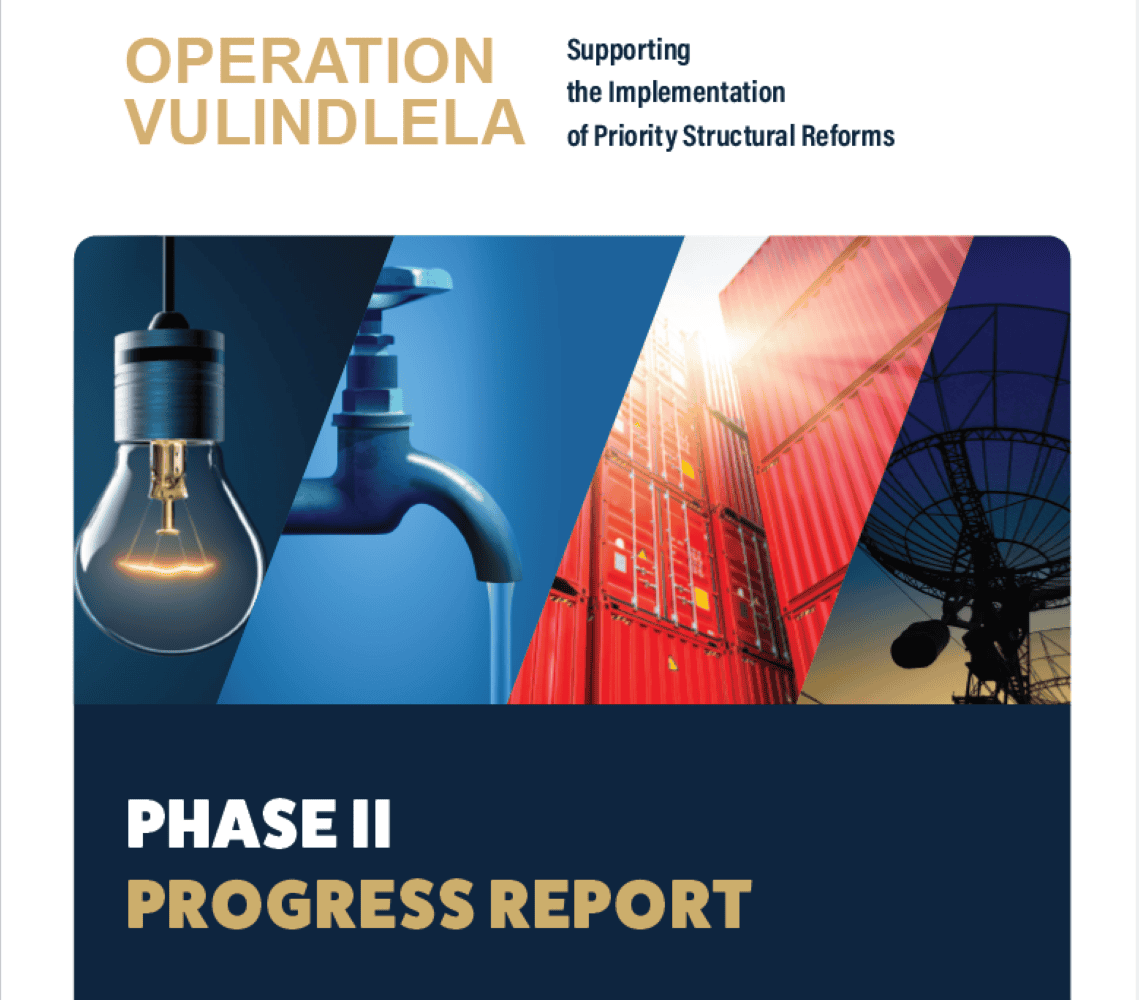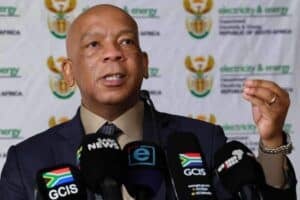Operation Vulindlela aims to modernise and transform network industries, including electricity, water, transport and digital communications.

Operation Vulindlela is bearing fruit, and this joint initiative of the Presidency and National Treasury to accelerate the implementation of structural reforms and support economic recovery is continuing to build momentum in the second quarter.
According to the progress report for the second quarter of Operation Vulindlela, the reform priorities in Phase II aim to drive more rapid and inclusive growth by removing the structural constraints that held back our economy for more than a decade.
Network industries are the bedrock of economic growth and essential to creating a globally competitive economy.
ALSO READ: Housing, local gov and digital transformation at the forefront of Operation Vulindlela phase II
More energy for energy in Operation Vulindlela
In the energy sector, work to establish a competitive electricity market is now advanced, and the pipeline of private investment in new generation capacity, largely from renewable energy sources, continues to grow.
The report points out that a clear framework to enable independent transmission projects (ITPs) in support of the Transmission Development Plan is now in place, and work is underway to launch the first phase of ITP procurement.
The National Transmission Company of South Africa (NTCSA) also submitted its application for a market operator license to National Energy Regulator of South Africa (Nersa) and finalised a draft Market Code.
While concerns were raised regarding the impediments to wheeling electricity and the treatment of electricity traders in the interim grid capacity allocation rules, Nersa is expected to finalise the Grid Capacity Allocation Rules by the end of 2025 and the Electricity Trading Rules by January 2026.
Operation Vulindlela is working closely with the National Treasury and the Department of Electricity and Energy to put in place a detailed plan for the establishment of a fully independent Transmission System Operator aligned to the requirements of the ERA.
The report shows that the most recent South African Renewable Energy Grid Survey indicated that 220 GW of projects are now in development in the private sector, of which 72 GW are advanced.
ALSO READ: ‘Operation Vulindlela update provides detailed progress’ – Presidency
Logistics are now on the rails in Operation Vulindlela
Significant progress was also made in the logistics sector towards enabling open access to the freight rail network, with the allocation of capacity to 11 private train operating companies across 41 routes. The revised Network Statement is expected to be published by the end of January 2026, which will establish an effective framework for operators to access the network on fair and commercially viable terms.
After an enthusiastic market response to the request for information published by the PSP Unit in March, the development of opportunities for private sector participation in strategic rail and port corridors is now underway, towards the release of the first request for proposals.
ALSO READ: ‘This is not progress’: Operation Vulindlela report sparks debate
Other reforms in Operation Vulindlela
Meanwhile, in the water sector, the report records that progress to establish the National Water Resources Agency is advanced, and the Water Services Amendment Bill has been introduced in Parliament to reform water service delivery.
Reforms to the visa system also yielded substantial results, with a backlog of over 300 000 visas cleared and processing times reduced for all visa categories. The Electronic Travel Authorisation (ETA) system was developed and is now being implemented for the G20 Summit, enabling more remote application and issuance of visas for applicable countries.
The Trusted Tour Operator Scheme has so far supported 35 000 tourist arrivals since its inception, creating jobs and supporting local businesses.
ALSO READ: Mashatile: How national government is aiming to reform local municipalities
Operation Vulindlela’s new reform areas
The report also shows progress in the new reform areas relating to local government performance, spatial inequality and digital transformation. The review of the White Paper on Local Government is underway, with 266 responses received after the discussion paper was published in May. These comments will inform the review of the institutional structure.
The Metro Trading Services Reform Programme is also fully implemented, providing an incentive for metros to ring-fence, professionalise, and turn around the performance of their electricity and water services. Detailed work was undertaken to identify and remove the barriers to investment in affordable housing and to accelerate the release of public land.
Implementation of the Digital Transformation Roadmap is in full swing, with the launch of the MyMzansi data exchange to enable the secure sharing of data across government, according to the report.
ALSO READ: Ramaphosa slams opposition parties’ criticism of economic reform
Operation Vulindlela’s key milestones in the second quarter
The report identifies these key milestones for Operation Vulindlela in the second quarter:
- Nersa is expected to make a decision on the application for a Market Operator license by the National Transmission Company of South Africa (NTCSA) in November 2025, after a public hearing was held on 30 September 2025.
- The revised Market Code, which outlines the rules to govern South Africa’s wholesale electricity market, was developed through an extensive process of consultation with key stakeholders ending on 11 September 2025. The code will be submitted to Nersa by the NTCSA once the Market Operator license is obtained.
- Nersa initiated processes to establish Electricity Trading Rules as well as Grid Capacity Allocation Rules to ensure fairness, transparency and non-discrimination in access to the grid and trading of electricity. The Final Grid Capacity Allocation Rules will be published by the regulator by the end of 2025, while the Electricity Trading Rules, which were released for public comment, will be finalised by 31 January 2026. These rules will support the establishment of a competitive market and provide a predictable regulatory framework for investment in generation capacity.
- The 2025 South African Renewable Energy Grid Survey shows that 220 GW of solar, wind and battery storage projects are now in development, an increase from 134 GW in 2024. Of these, 72 GW are at an advanced stage, with environmental approval and a power purchase agreement signed or close to signature.
- A gap analysis of systems and processes required for the Market Operator function of the NTCSA was completed, and work is underway to establish the infrastructure and capacity required to operate the market. The NTCSA launched the South African Wholesale Electricity Market (SAWEM) School in July 2025 to support the training and accreditation of future market participants.
- Six additional preferred bidders with a total capacity of 1 290 MW were announced for the seventh round of the renewable energy procurement programme (REIPPPP 7) in July 2025, bringing the total capacity secured through the bid window to over 3200 MW.
- The 153 MW Red Sands project under the second round of the battery storage procurement programme achieved commercial close and will now proceed to construction in the Northern Cape. The Tournee Solar Park, a 300 MW solar PV project in Mpumalanga, is the first project to reach financial close through Eskom’s land lease programme, one of the initial programmes to be implemented through the Energy Action Plan.
- A Request for Qualifications (RFQ) for the first phase of Independent Transmission Projects (ITPs) was launched on 31 July 2025. These projects will enable private investment in transmission infrastructure for the first time, accelerating the rollout of new high-voltage power lines across the country.
- An additional 800 MW of capacity was added to the grid following the commissioning of Unit 6 at Kusile Power Station, marking the culmination of Eskom’s Build Programme.
- Eskom returned to profitability for the first time in eight years following its significant recovery in operational performance and the implementation of the Eskom Debt Relief Act.
- Eskom published a Congestion Curtailment Practice Note to unlock 3 470 MW additional grid connection capacity, particularly in the Eastern Cape and Western Cape, regions with significant renewable energy potential. This will enable the additional capacity to be allocated to qualifying projects.
ALSO READ: Steel Federation hopeful Operation Vulindlela will bring change
What comes next for Operation Vulindlela?
With everything that was achieved in the second quarter, the question is: what comes next? The report indicates these next steps for the third and fourth quarters of 2025:
- Obtain a decision by Nersa on the application for a Market Operator license by the NTCSA (November 2025).
- Finalise and submit the Market Code to Nersa for approval to establish a competitive wholesale electricity market (November 2025).
- Issue a Request for Proposals (RFP) for the first phase of independent transmission projects (November 2025).
- Publish detailed guidance on the structure of the competitive electricity market (January 2026).
- Publish the final Grid Capacity Allocation Rules and finalise the Electricity Trading Rules following consultation with key stakeholders (January 2026).
- Develop a detailed implementation plan for the establishment of the Transmission System Operator (TSO) outside Eskom and implement measures to ensure functional independence of the NTCSA during the transition period (March 2026).
- Publish the Electricity Distribution Industry (EDI) Reform Roadmap for public comment (March 2026).






